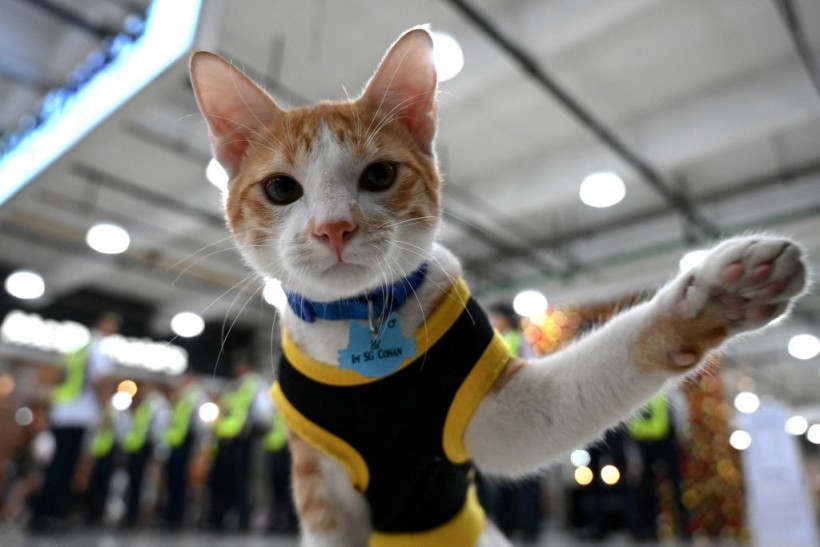Cats are known for their aloof and independent personalities, but they also have a complex social system that relies on subtle cues and signals.
One of the ways that cats communicate with each other and with humans is through scent marking, which involves rubbing their cheeks, chin, or tail on objects or people.
But what makes these scents so distinctive and meaningful? The answer may lie in the bacteria living in their butts.
The KittyBiome project: Crowdsourcing cat poop for science
 (Photo : JAM STA ROSA/AFP via Getty Images)
(Photo : JAM STA ROSA/AFP via Getty Images)

To understand how the cat microbiome affects their health and behavior, a group of researchers from the University of California (UC) Davis launched a crowd-funded research platform called KittyBiome.
The project aims to study the gut microbiota of at least 1000 cats, including domestic, shelter, and feral cats, as well as cats with different health conditions.
The researchers also want to compare the microbes found in the cat's anal glands, which secrete a fluid that is used for scent marking.
The KittyBiome project was started by microbial ecologist Holly Ganz, who said that she was fascinated by the microbes found in cat guts and their anal glands and how these microbes might be linked to social behavior.
Ganz hopes to use the research program to make real improvements to animal welfare: "A lot of cats and kittens with chronic diarrhea are euthanized, and if we could come up with something to help counteract this, we could be saving lives."
To fund their research, the KittyBiome team used Kickstarter to seek help from the general public.
They involved their citizen scientist backers in the program by asking them to send cat poop samples for sequencing.
They also offered rewards such as personalized microbiome reports, cat-themed merchandise, and even naming rights for new bacterial species discovered in the cat microbiome.
Also Read: Study Finds That Cats Exposed to Organic Pollutants Can Have Severe Illnesses
The secret life of cat butt bacteria
One of the first KittyBiome-funded experiments involved a male Bengal cat named Keanu, whose anal sac secretions were sent to the researchers by veterinarian Leah Isaacson as part of a regular health check-up.
The researchers analyzed the bacterial composition of the fluid and found that it was dominated by six genera, accounting for 98% of the bacteria.
These genera were Corynebacterium, Staphylococcus, Porphyromonas, Peptoniphilus, Anaerococcus, and Finegoldia.
The researchers also compared the anal sac microbiota of Keanu with that of two other male cats, a domestic shorthair named Milo and a Maine Coon named Leo.
They found that the three cats had similar bacterial profiles, but also some differences in the relative abundance of certain genera.
For example, Keanu had more Corynebacterium and less Staphylococcus than the other two cats.
The researchers speculated that these differences might reflect the individuality of each cat's scent, which could be influenced by factors, such as diet, health, genetics, and environment.
They also suggested that the anal sac bacteria might play a role in producing volatile organic compounds (VOCs) that are responsible for the odor of the secretions.
VOCs are known to be involved in chemical communication in many animals, including dogs, mice, and humans.
The researchers also noted that the anal sac microbiota was less diverse than the gut microbiota, which contains hundreds of species across dozens of genera.
They hypothesized that this might be due to the selective pressure exerted by the host's immune system, which could favor certain bacteria that are beneficial or harmless, and eliminate those that are harmful or irrelevant.
They also proposed that the anal sac microbiota might have co-evolved with the host to facilitate social interactions and mate recognition.
The KittyBiome project is still ongoing, and the researchers hope to collect more samples from different cats and analyze them using advanced techniques such as metagenomics and metabolomics.
They also plan to conduct experiments to test the effects of probiotics, antibiotics, and diet on the cat microbiome and its impact on health and behavior.
By doing so, they hope to uncover the secrets of the cat butt bacteria and how they help cats communicate with the world.
Related article: Humans Can Communicate with Cats by Blinking the Eyes Slowly and Using Other Facial Gestures
© 2024 NatureWorldNews.com All rights reserved. Do not reproduce without permission.





